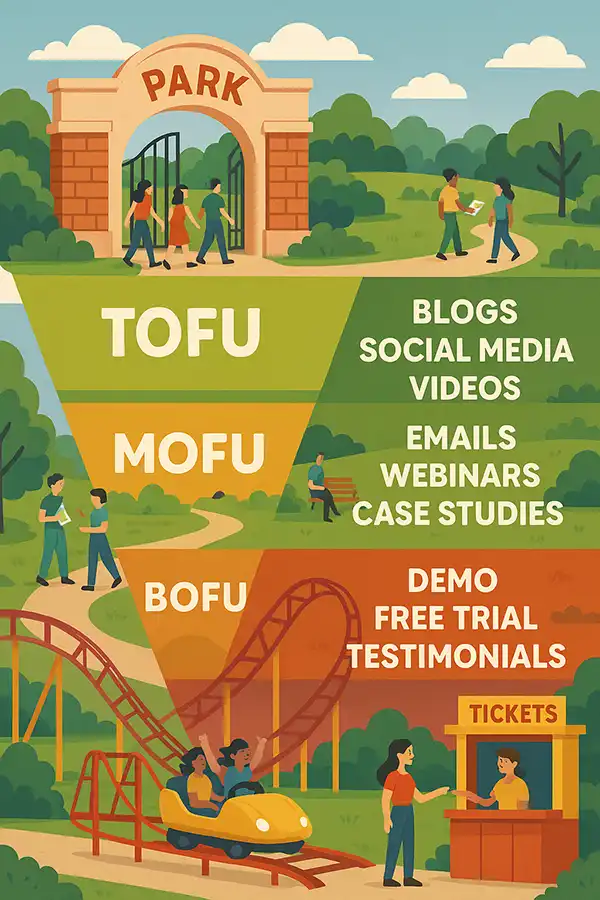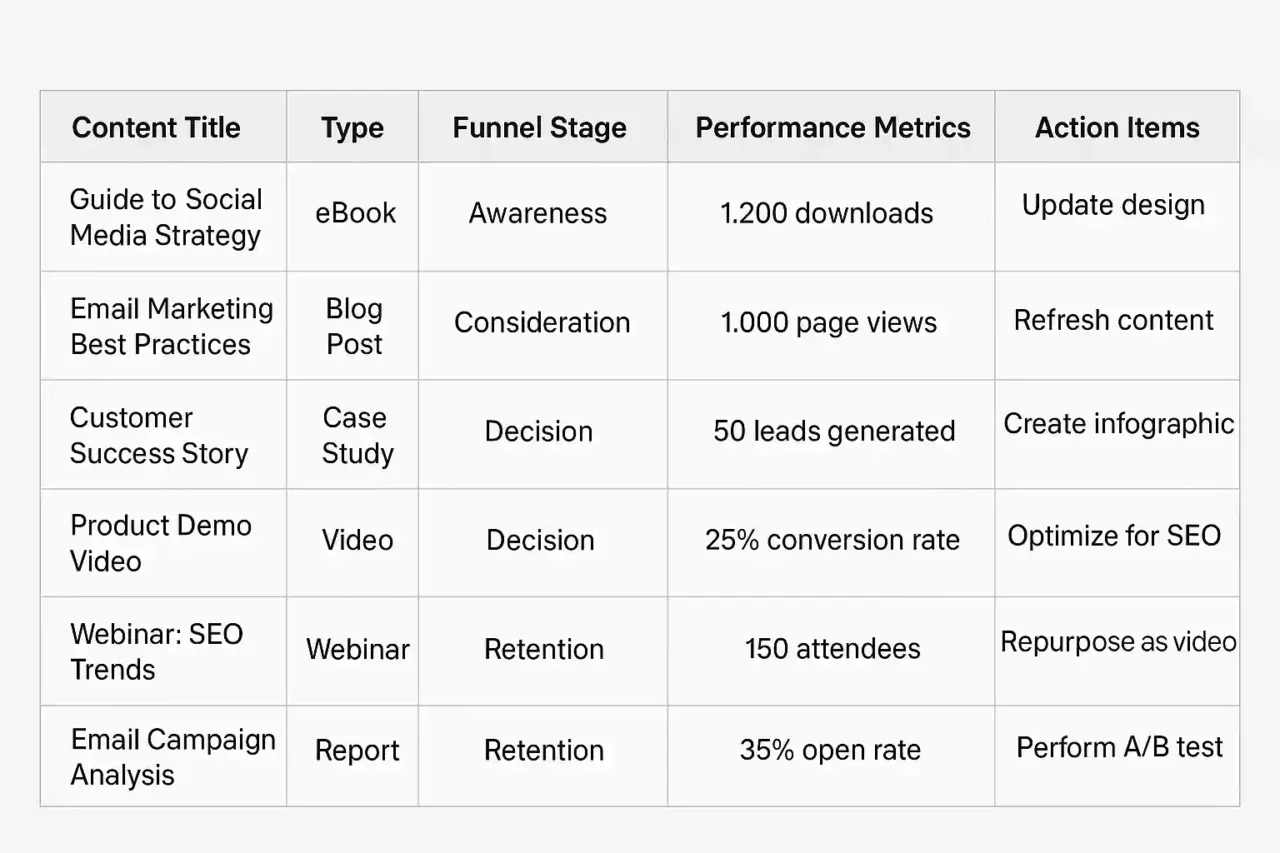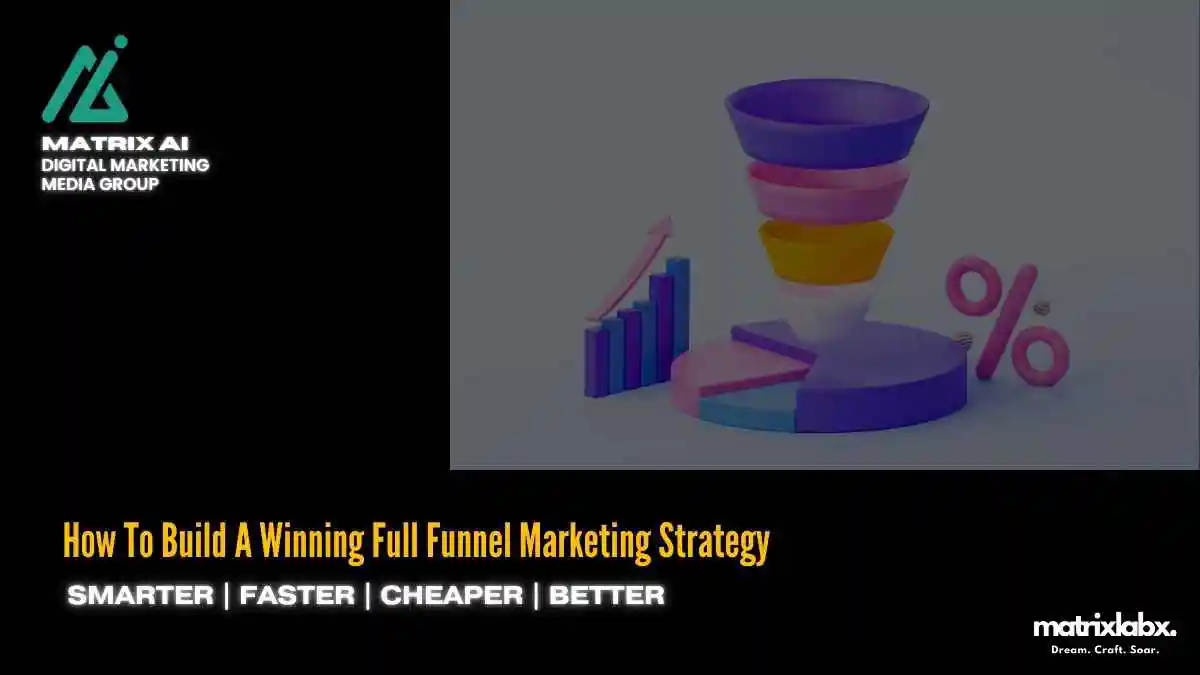How To Build A Winning Full Funnel Marketing Strategy
How To Build A Winning Full Funnel Marketing Strategy
In today’s complex digital landscape, customers interact with brands through various channels and stages of the buying journey.
A full-funnel marketing strategy addresses this complexity by guiding potential customers from awareness to conversion.
Building a full-funnel strategy isn’t just a smart move—it’s necessary for marketing managers who want to optimize campaigns and maximize ROI.
Why Marketing Managers Need a Full-Funnel Approach
Unlike traditional marketing methods that often focus solely on lead generation or conversion, a full-funnel strategy ensures continuous engagement throughout the customer journey.
According to Kotler and Keller (2016), integrated marketing communications are essential for maintaining brand consistency and customer trust.
Marketing managers who adopt a full-funnel approach can effectively tailor messaging to meet prospects where they are—whether they’re just learning about your brand or ready to purchase.
This strategy helps solve common challenges such as high customer acquisition costs, low conversion rates, and inconsistent platform branding.
It also provides valuable insights into audience behavior at each funnel stage, allowing for better data-driven decision-making.
Marketing Waste ROI Calculator
Results
Estimated Waste Budget: $0
Revenue Potential with Optimization: $0
ROI Boost Opportunity: 0X
Key Steps to Building a Full-Funnel Marketing Strategy
Developing a full-funnel strategy requires thoughtful planning and execution across three primary stages: awareness, consideration, and conversion.
Each stage plays a crucial role in the customer journey and demands a unique set of tactics.
1. Awareness Stage
The goal is to attract attention and drive traffic. To introduce your brand to new audiences, utilize top-of-funnel tactics such as social media ads, SEO, and influencer partnerships.
2. Consideration Stage
At this point, potential customers are evaluating options. Content marketing, webinars, email nurturing campaigns, and case studies build trust and demonstrate value.
3. Conversion Stage
Now it’s time to close the deal. Tactics like retargeting ads, personalized email offers, and limited-time promotions can help nudge leads toward a purchase.
A winning full-funnel marketing strategy is comprehensive, data-driven, and customer-centric. For marketing managers seeking scalable growth and long-term customer relationships, mastering the full funnel isn’t just advantageous—it’s essential. 10 Most In-Demand Types of SEO Services to Focus On in 2025
How to Build a Winning Full Funnel Marketing Strategy
Creating a successful full-funnel marketing strategy involves more than crafting a few ads or social media posts.
It requires a comprehensive approach that guides potential customers through every stage of the buyer’s journey, from awareness to conversion.
A well-executed full-funnel strategy increases visibility, builds trust, and drives long-term customer loyalty.
Understanding the Full Funnel
The marketing funnel is typically divided into three stages: top (awareness), middle (consideration), and bottom (conversion).
Your goal at the top is to attract attention and generate interest. In the middle, you nurture leads by providing valuable content and solutions.
At the bottom, you convert leads into customers through targeted offers and calls to action.
Gathering the Right Materials and Tools
To build a winning strategy, you’ll need a variety of resources:
- Audience data: Understand who your ideal customers are, as well as their demographics, interests, and behaviors.
- Content assets: Blog posts, videos, infographics, case studies, and email templates tailored to each funnel stage.
- Marketing platforms: Tools like Google Analytics, CRM software (e.g., HubSpot or Salesforce), email marketing platforms, and social media schedulers.
- Keyword research tools: Use SEMrush, AISEOPad, or Google Keyword Planner to align content with user intent.
- Performance metrics: KPIs such as conversion rates, click-through rates, and customer acquisition cost help measure success.
Tips for Gathering Materials
Start by conducting market research using surveys, social media listening, and competitor analysis.
Use analytics platforms to gather insights about your current audience and website performance.
Leverage free and paid tools for keyword research and content ideation. Collaboration with sales teams can also provide valuable insights into customer pain points and objections.
The Importance of Preparation
Preparation is the cornerstone of a successful full-funnel strategy. Your efforts may lack focus and effectiveness without clearly understanding your audience, goals, and available resources.
Organizing your materials and tools in advance ensures consistency across campaigns, improves ROI, and creates a seamless experience for your audience.
In conclusion, building a winning full-funnel marketing strategy requires thoughtful planning, the right tools, and a deep understanding of your audience.
With preparation and a clear roadmap, you can confidently guide prospects from awareness to advocacy.
How To Build A Winning Full Funnel Marketing Strategy

Creating a successful full-funnel marketing strategy is like constructing a well-designed amusement park.
Each section of the park is tailored to meet visitors at different stages of their experience, just as each stage of the marketing funnel addresses a unique point in the customer journey.
From the moment someone hears about your brand to the final purchase and beyond, every touchpoint must be intentional, engaging, and aligned.
Top of Funnel: Attracting the Crowd
The top of the funnel (TOFU) is your park’s grand entrance, which aims to attract as many visitors as possible.
This stage relies on broad-reach tactics like social media advertising, blog content, and SEO. The focus is on awareness, helping potential customers discover your brand and feel intrigued enough to explore further.
Middle of Funnel: Engaging with Value
Once inside the park, visitors begin to explore. Prospects consider their options in the middle of the funnel (MOFU). Offer them value through email campaigns, webinars, or product comparisons. This is where you build trust and nurture interest.
Think of it as guiding them toward the most exciting rides that match their preferences and needs.
Bottom of Funnel: Converting with Confidence
At the bottom of the funnel (BOFU), your visitors are ready to buy tickets to their favorite ride. Use personalized offers, case studies, and demos to convert interest into action.
The experience should be seamless, and deciding to buy is the natural next step.
A winning full-funnel marketing strategy requires cohesion and creativity at every stage. Like a well-run amusement park, your funnel should attract, delight, and convert, turning curious visitors into loyal fans.
How to Build a Winning Full Funnel Marketing Strategy and Why It’s Important
In today’s dynamic digital landscape, businesses must do more than attract attention—they must guide potential customers through every stage of the buyer’s journey.
A full-funnel marketing strategy ensures that marketing efforts align with customer behavior from awareness to conversion.
This approach improves marketing efficiency, enhances customer experience, and drives long-term growth.
Understanding the Full Funnel Marketing Approach
A full funnel marketing strategy addresses the entire customer journey by targeting three primary stages: the top of the funnel (TOFU), middle of the funnel (MOFU), and bottom of the funnel (BOFU). Each stage corresponds to a different level of customer intent:
- TOFU: Focuses on building awareness and attracting potential customers through content marketing, social media, and advertising.
- MOFU: Engages prospects by providing value and nurturing leads through email campaigns, webinars, and case studies.
- BOFU: Converts leads into customers with targeted offers, product demos, and personalized messaging.
Marketers can create seamless transitions that guide users toward conversion by strategically aligning content and messaging with each stage.
Matrix Marketing ROI Calculator
Challenges and Opportunities in Building a Full Funnel Strategy
While the benefits of a full funnel marketing strategy are significant, implementing one effectively comes with its own set of challenges and opportunities.
Challenges
1. Aligning Cross-Functional Teams
One of the most common challenges is ensuring alignment across marketing, sales, and customer success teams.
Each team may have different goals and KPIs, leading to disjointed messaging and customer experiences. A unified strategy requires open communication, shared metrics, and integrated tools.
2. Creating Personalized Content at Scale
Full funnel marketing demands content tailored to different audience segments and funnel stages.
Developing and managing this content at scale can be resource-intensive. Organizations must invest in content planning, marketing automation, and customer data platforms to streamline personalization efforts.
3. Measuring Funnel Performance
Tracking the effectiveness of a full funnel strategy requires robust analytics. Marketers must understand how prospects move through the funnel and which touchpoints drive conversions.
This can be complex, especially when dealing with multi-channel campaigns and long sales cycles.
Opportunities
1. Enhanced Customer Experience
A well-executed full-funnel strategy creates a more cohesive and personalized customer experience.
By delivering the right message at the right time, businesses can build trust and foster deeper relationships, increasing the likelihood of conversion and retention.
2. Improved Marketing ROI
Marketers can improve conversion rates and reduce customer acquisition costs by focusing efforts on nurturing leads throughout the funnel.
A data-driven full-funnel approach allows for better resource allocation and more informed decision-making.
3. Competitive Differentiation
Many businesses still operate with siloed marketing efforts. Companies can differentiate themselves through a more strategic, customer-centric approach by adopting a full-funnel strategy.
This positions them as industry leaders who understand and respond to their audience’s needs at every stage.
How to Build a Winning Full Funnel Marketing Strategy
Creating a successful full-funnel marketing strategy requires a thoughtful, data-driven approach that guides potential customers through every stage of their journey—from awareness to conversion.
In today’s competitive digital landscape, businesses can no longer rely on isolated marketing efforts.
Instead, they must develop integrated strategies that nurture leads at each touchpoint of the funnel.
Goal of a Full Funnel Marketing Strategy
The primary goal of a full funnel marketing strategy is to attract, engage, and convert leads while building long-term relationships with customers.
This approach ensures that no matter where a prospect is in their decision-making process, they receive relevant content and support that moves them closer to purchase.
Success is measured by increased conversions and sales, improved customer retention, higher lifetime value, and a stronger brand reputation. A winning strategy helps marketing and sales teams align efforts, resulting in more efficient campaigns and better resource use.
What Success Looks Like
A well-executed full funnel strategy delivers measurable results across all customer journey stages. Here are key indicators of success:
- Top of Funnel (Awareness): Increased website traffic, social media engagement, and brand visibility.
- Middle of Funnel (Consideration): Higher email open and click-through rates, longer time on site, and more qualified leads.
- Bottom of Funnel (Conversion): Increased sales, improved conversion rates, and shorter sales cycles.
- Post-Purchase (Loyalty): Repeat purchases, strong customer reviews, and referrals.
When your full funnel strategy works, you’ll notice more seamless transitions between stages, fewer drop-offs, and greater overall customer satisfaction.
Setting Realistic Expectations
It’s important to understand that building a full funnel strategy is a long-term investment. Results may not be immediate, especially at the top of the funnel where brand awareness takes time to build.
Businesses should expect to iterate and optimize their strategies based on performance data and customer feedback.
Realistically, you can expect incremental improvements within the first 3–6 months, with more significant gains in lead quality and conversion rates by months 6–12.
Patience and consistency are key—successful full-funnel marketing requires ongoing analysis, testing, and refinement.
Common Mistakes to Avoid
Many businesses make critical errors when attempting to implement a full funnel strategy. Avoid these common pitfalls:
Ignoring the Customer Journey
Focusing solely on one stage of the funnel—usually the bottom—can alienate potential customers who aren’t yet ready to buy.
A successful strategy must consider the entire journey and provide tailored content for each stage.
Lack of Alignment Between Teams
Marketing and sales teams often operate in silos, leading to disjointed messaging and missed opportunities.
Ensure that both teams collaborate to define shared goals, ideal customer profiles, and lead qualification criteria.
Not Leveraging Data
Failing to use analytics to track user behavior and campaign performance can result in wasted budget and missed insights.
Use data to inform your decisions, personalize your messaging, and optimize your funnel.
Inconsistent Branding and Messaging
Inconsistency across channels and stages can confuse or alienate prospects.
To build trust and recognition, maintain a unified brand voice and message throughout the funnel.
Neglecting Post-Purchase Engagement
Many marketers stop nurturing customers after a sale. However, loyal customers are your most valuable asset.
Continue engaging them through email, exclusive offers, and quality content to encourage repeat business and referrals.
A winning, full-funnel marketing strategy isn’t about quick wins—it’s about building a sustainable, customer-centric approach that delivers long-term growth.
By setting clear goals, managing expectations, and avoiding common pitfalls, businesses can create a seamless journey that converts leads and fosters lasting relationships. Stay committed, stay flexible, and let your data guide the way.
How to Build a Winning Full-Funnel Marketing Strategy: A Step-by-Step Guide
Marketing today requires more than a catchy slogan or a one-time email blast.
Consumers move through a complex journey before purchasing, and marketers must meet them at every stage. That’s where a full-funnel marketing strategy comes in.
By guiding potential customers from awareness to conversion—and beyond—you can create a seamless and effective customer experience.
This guide offers step-by-step instructions for building a full-funnel marketing strategy that drives results.
Whether you’re a seasoned marketer or just starting, this roadmap will help you create a strategy that nurtures leads, builds trust, and converts prospects into loyal customers.
This guide offers step-by-step instructions for building a full-funnel marketing strategy.
Step 1: Define Your Buyer Personas and Customer Journey
Why This Step Is Crucial
Before launching any marketing campaign, you must know who you’re talking to. Buyer personas are semi-fictional representations of your ideal customers based on market research and real data.
Understanding their needs, goals, and pain points allows you to tailor messaging and content for each funnel stage.
How to Do It
- Gather Data: Use customer surveys, interviews, CRM data, and website analytics to gather insights about your audience.
- Segment Your Audience: Group customers by shared characteristics like demographics, behavior, and purchase history.
- Map the Customer Journey: Identify your customers’ stages—from awareness to consideration, decision, and loyalty.
Tips for Success
- Include real quotes from customer interviews to humanize personas.
- Use tools like HubSpot’s Make My Persona or Xtensio to create visual profiles.
- Revisit and revise personas regularly as your business grows and markets shift.
Pro Tip: Don’t just focus on one persona. Most businesses serve multiple customer types with unique journeys.
Step 2: Audit Your Existing Marketing Content and Channels

Why This Step Matters
Before you can build a winning strategy, you need to understand what’s already working and what’s not. A content audit helps identify gaps, redundancies, and opportunities across the funnel.
How to Do It
- Inventory All Content: List every blog post, email campaign, social media post, video, and ad.
- Categorize by Funnel Stage:
- Top of Funnel (TOFU): Awareness content like blog posts, social media, and infographics.
- Middle of Funnel (MOFU): Consideration content, such as case studies, webinars, and comparison guides.
- Bottom of Funnel (BOFU): Decision content like demos, free trials, and testimonials.
- Analyze Performance: Use analytics tools (Google Analytics, HubSpot, etc.) to evaluate engagement, conversion rates, and ROI.
Troubleshooting Common Issues
- Problem: Duplicate or outdated content.
- Fix: Consolidate or update with current stats and messaging.
- Problem: Missing BOFU content.
- Fix: Create assets like product demos, customer testimonials, and pricing pages.
Step 3: Align Marketing Goals with Business Objectives
Why This Step Is Important
Your marketing strategy should directly support your business goals—increasing revenue, growing market share, or improving customer retention. Clear goals ensure alignment across teams and help measure success effectively.
How to Do It
- Set SMART Goals: Specific, Measurable, Achievable, Relevant, Time-bound.
- Link Goals to Funnel Stages:
- Awareness: Increase website traffic by 25% in Q2.
- Consideration: Generate 500 marketing-qualified leads (MQLs) per month.
- Decision: Improve lead-to-customer conversion rate by 15%.
Supporting Details
- Use OKRs (Objectives and Key Results) to keep teams accountable.
- Align KPIs with each funnel stage for focused measurement.
Pro Tip: Share your goals across departments (sales, product, customer success) to ensure a unified approach.
Step 4: Develop Tailored Content for Each Funnel Stage
Why Content Customization Matters
Consumers expect relevant and timely content. Tailoring your messaging ensures you’re meeting your audience’s needs at the right moment, which builds trust and improves conversion rates.
How to Do It
- TOFU (Awareness): Educate and attract.
- Blog posts, social media, SEO, and video explainers.
- MOFU (Consideration): Nurture and inform.
- Whitepapers, webinars, case studies, and email campaigns.
- BOFU (Decision): Convert and close.
- Demos, testimonials, pricing guides, sales calls.
Tips for Success
- Repurpose content across channels (e.g., turn a blog into a video).
- A/B test headlines, CTAs, and formats.
- Use marketing automation to deliver content based on user behavior.
Visual Aid: Funnel diagram showing content types
Troubleshooting and FAQs
Crafting a successful full-funnel marketing strategy can be rewarding and complex. As you implement your plan, you may encounter obstacles that require adjustments and creative thinking. This section addresses common challenges, offers quick fixes, and encourages a mindset of experimentation and continuous improvement.
Why is my campaign not generating leads despite high traffic?
Potential Issue: While your top-of-funnel (TOFU) efforts may be driving traffic, your middle-of-funnel (MOFU) or bottom-of-funnel (BOFU) content may not be compelling or targeted enough to convert visitors into leads.
Quick Fix: Reassess your lead magnets and calls to action (CTAs). Ensure they align with your audience’s needs and the stage of the buyer’s journey. A/B test different offers, such as eBooks, webinars, or free trials, to determine what resonates most.
Encouragement: Experiment with different content formats and messaging. Use heatmaps and analytics to understand user behavior and adjust your strategy accordingly.
My audience engagement drops significantly after the awareness stage. What should I do?
Potential Issue: There may be a disconnect between your TOFU content and what you offer in the MOFU and BOFU stages.
Quick Fix: Create a seamless content journey. Map out your funnel and ensure each stage logically builds upon the previous one. Incorporate retargeting ads and email nurturing campaigns to re-engage users and guide them through the funnel.
Encouragement: Don’t be afraid to test new segmentation strategies or personalized content. Understanding your audience’s pain points and motivations can dramatically improve engagement.
How do I measure success at each funnel stage?
Potential Issue: Without clear KPIs, it’s difficult to determine what’s working and where to optimize.
Quick Fix: Define specific metrics for each stage:
TOFU: Website traffic, impressions, social shares MOFU: Click-through rates (CTR), email signups, content downloads BOFU: Conversion rates, sales, customer acquisition cost (CAC)
Use tools like Google Analytics, HubSpot, or Salesforce to track performance and adjust tactics.
Encouragement: Marketing is iterative. Use data to inform decisions, but allow room for creativity and adaptation.
My funnel strategy works for one product but not another. Why?
Potential Issue: Different products often require tailored funnel strategies due to varying buyer personas and purchase cycles.
Quick Fix: Develop separate funnels for each product or service. Customize content, messaging, and channels to match the specific audience and buying process.
Encouragement: Treat each funnel as a unique experiment. Document your findings and apply successful tactics across other campaigns where appropriate.
How often should I revise my full funnel strategy?
Potential Issue: Static strategies can quickly become outdated in dynamic markets.
Quick Fix: Conduct quarterly reviews of your funnel performance. Evaluate metrics, customer feedback, and market trends to identify areas for improvement.
Encouragement: Embrace a culture of testing and learning. Small, incremental changes can lead to significant gains over time.
What if I have limited resources to implement a full funnel strategy?
Potential Issue: Small teams or startups may lack the bandwidth to create content and campaigns for every funnel stage.
Quick Fix: Prioritize based on your most immediate business goals. For example, if brand awareness is low, focus on TOFU content first. Repurpose existing assets across multiple stages to maximize efficiency.
Encouragement: Start small and scale gradually. Even a simplified funnel can be effective if it’s well-targeted and thoughtfully executed.
Conclusion
Building a winning full-funnel marketing strategy is not a one-size-fits-all endeavor. It requires ongoing evaluation, creativity, and a willingness to adapt.
By troubleshooting challenges and fostering a mindset of experimentation, you can create a strategy that not only attracts attention but also nurtures leads and drives conversions.
Remember, each challenge is an opportunity to refine your approach and better serve your audience.
Building a winning full-funnel marketing strategy requires a comprehensive, data-driven approach that aligns marketing efforts with each stage of the buyer’s journey—awareness, consideration, and conversion.
The key lesson is that success lies in integrating tactics across the funnel rather than treating each stage in isolation. Marketers must develop a deep understanding of their target audience, leveraging insights to craft tailored messaging and content that resonates at every touchpoint.
One of the most significant takeaways is the importance of collaboration between marketing and sales teams.
A full-funnel strategy demands seamless communication and alignment, ensuring that leads generated at the top of the funnel are nurtured effectively through the middle and bottom stages. This alignment improves lead quality and enhances customer lifetime value and retention.
Another critical lesson is the role of measurement and continuous optimization. A winning strategy is not static; it evolves based on performance metrics and feedback. Marketers must implement robust tracking mechanisms to evaluate the effectiveness of campaigns at each funnel stage and be agile enough to pivot when needed.
Utilizing tools like customer relationship management (CRM) systems, marketing automation platforms, and analytics dashboards allows for real-time insights and more informed decision-making.
Furthermore, content remains a cornerstone of full-funnel marketing. Each piece of content must serve a strategic purpose, from blog posts and social media for awareness to webinars and case studies for consideration to testimonials or demos for conversion.
The lesson here is clear: content must be relevant, personalized, and aligned with the user’s intent at each stage.
Ultimately, a winning full-funnel marketing strategy is about delivering the right message to the right person at the right time. Marketers can drive sustained growth and long-term success by embracing a holistic, customer-centric approach and committing to continuous improvement.
Building a winning full-funnel marketing strategy is essential in today’s customer-driven market.
While it presents challenges such as team alignment, content creation, and performance tracking, the opportunities for enhanced customer experience, increased ROI, and market differentiation make it a worthwhile investment.
By focusing on the entire customer journey, businesses can create meaningful engagements, convert leads more efficiently, and foster long-term loyalty.

